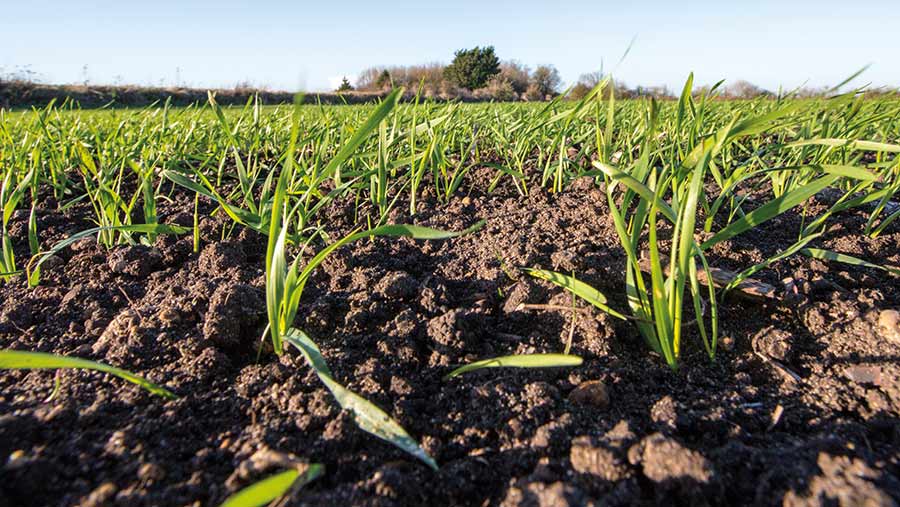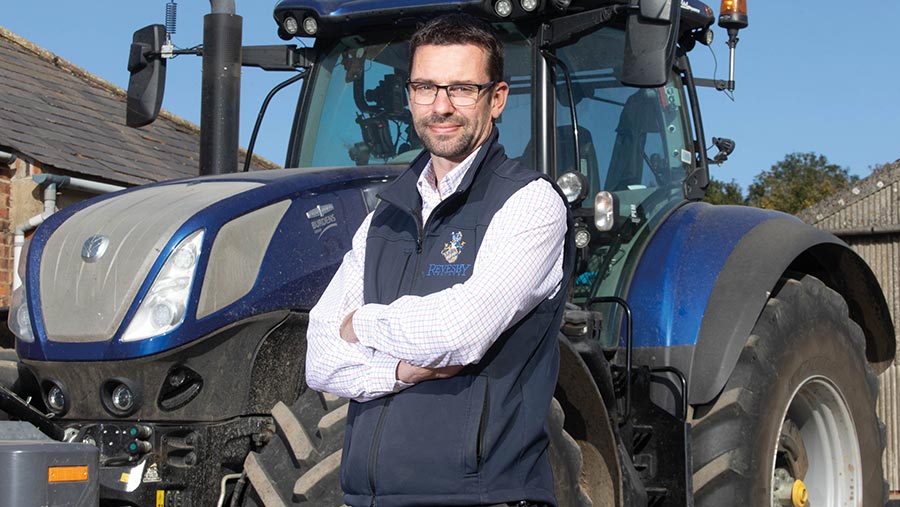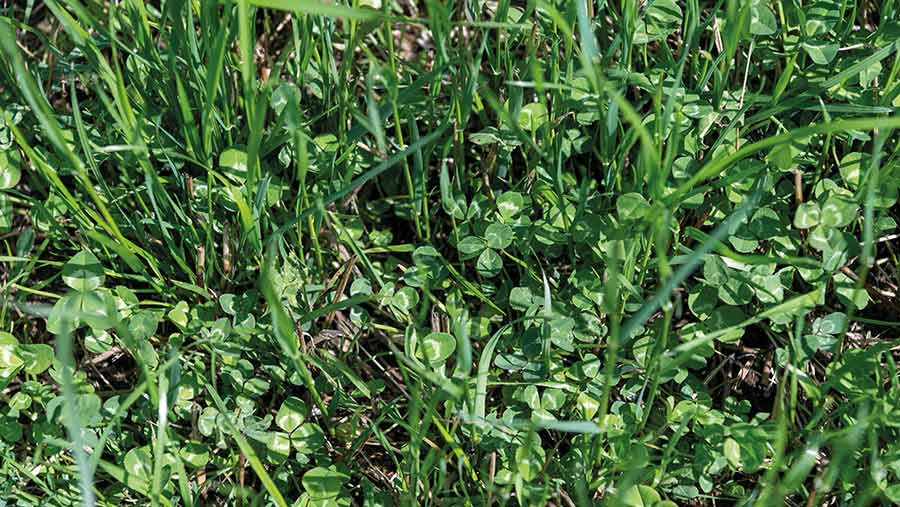Farm cuts diesel costs and improves yields in move to regen
 © Gary Naylor
© Gary Naylor Getting the basics right and changing systems slowly to get soil into the right place for direct drilling has been a successful strategy for Revesby Estate’s farm manager Peter Cartwright.
He oversees 1,100ha of in-hand cropping across mainly medium clay loams with some heavy sea-level land.
“I am a farm manager for an estate and report to a board so everything we do has to stack up financially.
“We cannot take risks, or I will be out of a job, so that’s why we took the slow approach and when we tweak something we make sure it provides a return.”
See also: Farm soil carbon: Is the focus on sequestration right?
Over the past eight years he has cut diesel use from 130 litres/ha to 70 litres/ha – a saving worth £60,000 to the business, while improving wheat yields by 1t/ha to 9.6t/ha.
Ultimately, he’s hoping to reduce diesel use further to 50 litres/ha, while increasing yields by another 1t/ha in the next four years.
“With all the data and trials we’re now going to see the big steps up in yield, depending on what Mother Nature throws at us.”
Drainage

Pater Cartwright © Tim Scrivener
An important first step was investing in completely new drainage schemes on 7-8% of the land, with dykes cleaned out.
“We are at sea level, so if we can’t get the water off the land, everything will fall down,” Mr Cartwright says.
When he arrived on the farm 10 years ago, he replaced the existing Vaderstad TopDown cultivator for a more versatile Horsch Terrano, which allowed shallower and shallower cultivations.
A switch to a 10m controlled traffic farming system followed in 2017, aided by buying a 10m Horsch Sprinter drill.
This has helped speed improvements in soil health, by allowing him to control and minimise soil compaction. It also contributed to that reduction in diesel use and a 1,200-hour saving in labour.
Ironically the Sprinter wasn’t the drill he really wanted after hosting a large drill demonstration the previous year, where he trialled a prototype Horsch Avatar.
“We’d started using cover crops in 2014, and knew we wanted a drill that could work with them and decided the Avatar was the drill for us.”
But he has only just purchased it this year, spending the time in between getting everything right with the soil first, rather than buying the drill and hoping the soil caught up.
“We’ve pulled levers slowly to allow soils to keep up, rather than forcing it to happen, which means we haven’t seen any drop in yields as we’ve gone along.”
A flatlift was the last piece of cultivation equipment to go, he says.
“We had to stop using the flatlift as we couldn’t travel after. Our soils were getting in such good condition, the flatlift was overworking them.”
Rotation changes
The rotation has changed, but not the amount of wheat.
Compared with 2014, he’s still growing around 50% wheat across the farm, but now it is all first wheat rather than a mixture of first and second wheats.
“We’ve now a higher proportion of spring break crops.”
A small area of sugar beet remains, but vining peas, which can destroy soil structure if harvested in wet conditions, have been replaced by spring beans.
This maintains the benefits of a pulse crop in the rotation with a better gross margin and improved soil health, he says.
The rotation has changed to facilitate the easier use of cover crops, which are now grown across 450ha each season, he says.
Different mixes and drilling dates are employed ahead of different cash crops, with phacelia, rye, vetch and oil radish established by the end of August ahead of spring oats.
The simple spring oat cover is not drilled until mid-September before spring beans.
“That allows me to spread my machinery working window, but still use cover crops.”
Spring beans are drilled “on the green” following a glyphosate spray to kill off the oats, while the covers ahead of spring oats are grazed by 250 head of sheep before being direct drilled with the Sprinter.
“We use the Sprinter as it gives a little bit of lift and takes out the 2-3cm compaction from the sheep.”
Direct drilled
Apart from sugar beet, everything is now direct drilled – part of the reason for having both the disc and tine drills is to provide flexibility in choosing which to use.
This allows for the capacity to drill all his wheat within a five-day window at the optimum time – usually the beginning of October.
An Agrii large plot wheat variety trial helps him select varieties suitable for direct drilling on the farm.
He also uses Agrii’s Liqui-Safe product to apply 66-100% of the crop’s nitrogen requirements in one pass at the beginning of the season, he says.
“It’s held within the soil without affecting any of the soil life, helping to further streamline the farming operation without any yield impact.”
Grain proteins are also going to be tracked this harvest from every trailer load, using a similar weighbridge system to that of the big intakes to help further tweak nitrogen use, he says.
“It will help us understand how our nitrogen strategy is working, whether we are over or underfeeding.”
That kind of attention to detail has been important throughout the transition, he says.
“It does get easier, but every single field needed my attention during the transition.
“I was having to dig every one to see where we needed to cultivate and to what depth. Now I don’t need to do that, as virtually every field is behaving the same.”
Oilseed rape yield comparison from undersown clover trials at Revesby Estate |
||
|
|
With undersown clover |
Non-clover |
|
Farm standard (190kgN/ha) |
4.9t/ha |
4.1t/ha |
|
Reduced (45kgN/ha) |
4.5t/ha |
3.7t/ha |
|
No N |
3.2t/ha |
2.8t/ha |
| Note: Oilseed rape grown in year five following clover establishment. Clover terminated after year three. | ||
Clover yield boost

Clover © Wayne Hutchinson
An experiment using undersown clover has shown a 0.8t/ha yield boost in oilseed rape, two years after the clover was destroyed, Peter Cartwright says.
The trial was set up as preparation for any future ban on glyphosate. “We are a heavily blackgrass-infested farm, so how can we cope without glyphosate?”
The clover was established in year one with oats, and then followed with winter wheat in year two.
Blackgrass suppression in the wheat was excellent with much less poking out of the top of the crop compared with the traditionally established other half of the field.
This also received a pre-emergence herbicide stack, unlike the undersown clover side.
But problems started to emerge. He couldn’t drill oilseed rape as it was too dry and the drill couldn’t penetrate, while mice ate most of the spring bean seed.
He was also struggling to drill through the clover with a drag tine drill. “We were starting to block the drill and cover the seed behind it – we were losing control.”
That led to the clover being destroyed ahead of the following winter wheat crop in year four.
But it was the following year’s oilseed rape where a big difference was seen, with a much bigger canopy and higher green area index, under two different nitrogen regimes.
“We had a 0.8t/ha uplift under the farm standard nitrogen of 190kg N/ha, and the same where we reduced the nitrogen to 45kg N/ha.”
With a disc drill as well as the tine drill it is a result that has encouraged him to look at again in a more continuous wheat situation.

